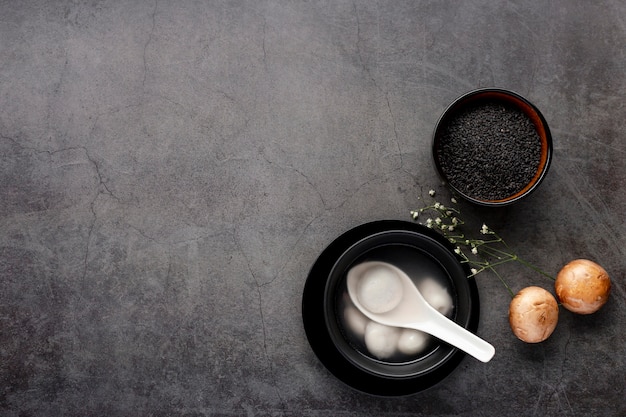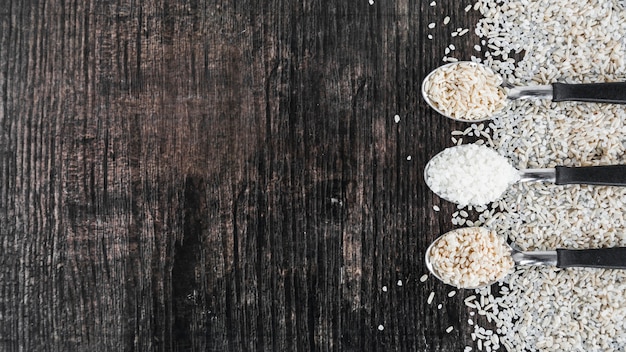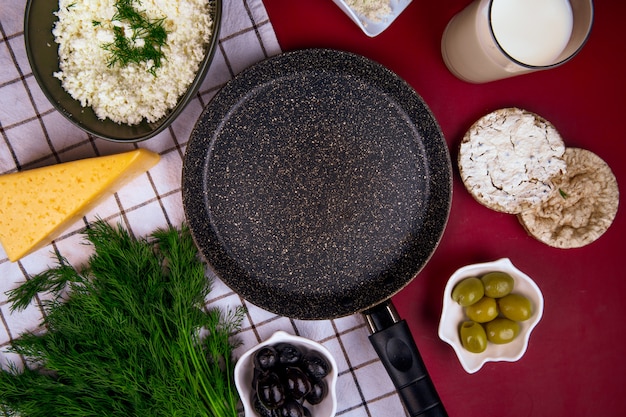black rice, with its enigmatic name "forbidden rice," has long been a whispered secret in culinary circles. Its deep, almost inky colour, and its unique nutty flavour, have captivated food enthusiasts. But for many home cooks, the question lingers: "Must you cook black rice?". Well, dear reader, the answer is a resounding YES. But that's just the beginning of our journey into the fascinating world of black rice.
(Part 1) - Unlocking the Secrets of Black Rice

Black rice isn't simply a darker shade of your average rice. It's a grain with a rich history and a unique character that deserves to be celebrated. Imagine being presented with a bowl of this captivating rice, its colour so deep it almost seems to absorb the light. That's the magic of black rice. It's not just about what it tastes like, it's about the story it tells, the history it whispers.
A Grain of Royalty: Black Rice's History
For centuries, black rice was a prized possession in ancient China, reserved exclusively for the emperor and his court. Its dark colour, a symbol of power and prosperity, earned it the name "forbidden rice." The thought of such a precious grain being withheld from the common folk always sparks a sense of wonder in me. It’s almost like a secret treasure, waiting to be unearthed.
Black Rice: More Than Just a Pretty Color
Beyond its captivating colour, black rice boasts a unique flavour and texture unlike its white or brown cousins. Imagine a nutty, subtly sweet flavour, with a hint of earthiness. It’s a complex, almost comforting taste that lingers on the palate. The secret to this unique flavour lies in the anthocyanins, the same pigments that give blueberries and blackberries their deep colour. These anthocyanins are also known for their powerful antioxidant properties. For me, it's a reminder that good food can be delicious and nourishing. It’s a win-win!
My First Black Rice Fiasco (And Lesson Learned)
My initial encounter with black rice was a bit of a culinary disaster. I followed a simple recipe, naively assuming it would be as straightforward as cooking any other rice. But, the results were a bit… mushy. It felt like I'd turned the rice into porridge! That's when I realized that black rice requires a bit more attention. It's not just about throwing it into a pot and hoping for the best. You need to understand its unique quirks, its personality, and adapt your cooking methods to suit it.
(Part 2) - Preparing Black Rice for Cooking: The Foundation for Success

Before we even think about bringing out the pot and the stove, we need to prepare the black rice. A few simple steps can make a world of difference in the final dish.
Washing Away the Starch: The Essential Rinse
Just like with any other rice, rinsing black rice is crucial. You want to remove the excess starch, which can make the rice stick together and become gummy during cooking. Imagine the perfect rice, each grain separate and firm, like little jewels in a bowl. That's what we're aiming for! So, give the rice a good rinse, under running water, until the water runs clear. It's a simple step that goes a long way.
Soaking for Enhanced Flavour: A Deeper Taste
While not essential, soaking the rice in water for at least 30 minutes, or even overnight, can significantly enhance the flavour and texture. The soaking allows the rice to absorb the water more evenly, resulting in a more consistent cooking process and a more intense flavour. I've found that soaking black rice, especially overnight, reveals a depth of flavour that's almost magical. It's like allowing the rice to breathe, to awaken its hidden potential.
(Part 3) - Finding the Perfect Ratio: A Culinary Balance

The key to mastering black rice lies in understanding the correct cooking ratio. It's not a one-size-fits-all situation. You need to find the right balance of rice and water for the desired outcome.
The Golden Ratio: A Guide for Beginners
A good starting point is to use 1.5 to 2 cups of water for every cup of black rice. It's a delicate dance. Too little water, and the rice will be dry and hard. Too much water, and you'll have mushy rice. The secret lies in finding that sweet spot, that perfect balance.
Adjusting the Ratio for Your Desired Texture
The beauty of cooking is in the flexibility. If you prefer a firmer rice, use a little less water. If you like a softer, more porridge-like consistency, go for a little more liquid. It’s about experimenting and finding what works best for you. I prefer a slightly softer texture, especially when I'm making a rice pudding or a sweet dessert. There's no right or wrong answer, it’s all about your personal taste and preference. It’s your culinary journey to explore, your personal masterpiece to create.
(Part 4) - Cooking Methods: Unlocking the Potential of Black Rice
Now that we've established the basics of preparation and the importance of the right ratio, let’s explore the different ways to cook black rice. From the classic stovetop method to the convenience of a rice cooker, there's a method for every kitchen and every taste.
The Stovetop Classic: Time-Tested and Reliable
The traditional stovetop method is a tried-and-true technique, passed down through generations of cooks. Simply bring the rice and water to a boil in a saucepan with a tight-fitting lid. Then, reduce the heat to a gentle simmer and cook for 30 to 45 minutes, or until the rice is tender and most of the liquid is absorbed. Remember, black rice takes longer to cook than its white or brown counterparts. Patience is key. I like to give the rice a gentle stir halfway through to ensure even cooking, and I watch for the steam escaping from the lid, a telltale sign that the rice is nearing perfection.
The Rice Cooker Revolution: Effortless Convenience
For a hands-free approach, a rice cooker is a modern marvel. Simply add the rice and water to the cooker, close the lid, and let it work its magic. Many rice cookers even have a dedicated setting for black rice, making life even easier. I can't sing the praises of my rice cooker enough, especially on busy weeknights. It’s a culinary lifesaver, ensuring perfectly cooked rice without any fuss.
Exploring Other Options: Expanding Culinary Horizons
For those who like to explore different culinary avenues, you can also cook black rice in the oven. Use a baking dish with a tight-fitting lid and cook at a low temperature for an extended period. The oven method often results in a slightly different flavour and texture, and it's perfect for larger batches. I enjoy experimenting with different cooking methods, especially when I'm making a big pot of black rice for a family gathering. It’s a way to add a touch of excitement to the process, to discover new nuances in flavour and texture.
(Part 5) - Black Rice Beyond the Basics: A World of Flavour
Now that we've mastered the fundamentals of cooking black rice, let's explore how to elevate it to new heights of flavour. This is where your creativity can truly shine.
A Burst of Flavour: Spices, Herbs, and Fruits
Black rice is incredibly versatile, embracing a wide array of flavours. Think about spices, herbs, and even fruits to create your own unique black rice dishes. One of my favourite flavour combinations is black rice with coconut milk, lime zest, and a touch of fresh ginger. It’s a taste of the tropics, a perfect blend of sweet and spicy, a culinary journey to a sun-drenched island.
The Power of Herbs: A Touch of Freshness
Don't underestimate the impact of fresh herbs. A sprinkle of cilantro, mint, or parsley can transform a simple dish into something truly special. I like to add a few sprigs of fresh basil when I'm making a black rice salad with tomatoes and mozzarella. The basil's delicate aroma blends perfectly with the other ingredients, creating a harmonious symphony of flavours.
Spice It Up: A culinary adventure
For those who like a little heat, black rice welcomes spices with open arms. Add a pinch of cayenne pepper for a subtle kick, a few flakes of red pepper for a bolder flavour, or even a spoonful of curry powder for a complex and aromatic experience. I love to make a black rice pilaf with cumin, coriander, and turmeric. It’s a fragrant and flavourful dish, a testament to the versatility of black rice.
(Part 6) - Black Rice in Action: Recipes to Inspire
Now that we've explored the world of flavour, let's delve into some inspiring recipes that showcase the versatility of black rice. These recipes are not just instructions, but gateways to culinary adventures.
Simple and Savoury: Black Rice Salad
For a light and refreshing meal, a black rice salad is a fantastic option. Toss cooked black rice with chopped vegetables, herbs, and a simple vinaigrette. Add grilled chicken, tofu, or chickpeas for extra protein. My favourite black rice salad is a blend of black rice, diced cucumbers, cherry tomatoes, red onion, and a sprinkle of feta cheese. It’s a colourful and satisfying dish, perfect for a summer picnic or a light lunch.
Warm and Comforting: black rice pudding
For a sweet treat, black rice pudding is a delicious and comforting dessert. Cook the rice in milk with sugar, vanilla extract, and cinnamon. You can add other ingredients like dried fruit, nuts, or even a drizzle of honey. I love to make a black rice pudding with a touch of maple syrup and a sprinkle of toasted pecans. It’s the perfect way to end a hearty meal, a warm and comforting hug for the soul.
Exotic and Flavourful: Black Rice with Coconut Milk
For a taste of the tropics, try making black rice with coconut milk. Simply cook the rice in coconut milk with a pinch of salt and a squeeze of lime juice. Add other spices like ginger, cardamom, or cinnamon for extra flavour. I like to serve this dish with grilled fish or chicken for a complete meal. It’s a light and refreshing dish, perfect for a warm summer evening, a culinary escape to a tropical paradise.
(Part 7) - Black Rice: A Culinary Treasure
Black rice is more than just a culinary curiosity. It's a treasure, a grain with a rich history and a unique character that deserves to be celebrated. With its deep purple hue, nutty flavour, and nutritional benefits, black rice is a culinary gem that deserves a place in every kitchen.
A Culinary Adventure
Cooking black rice can be an adventure, a chance to explore new flavours and experiment in the kitchen. Don't be afraid to try new things and find what works best for you. I’ve found that the most delicious recipes are often born from experimentation and embracing the unexpected. So, get creative, have fun, and enjoy the journey.
(Part 8) - FAQs about Black Rice
You have questions, I have answers. Here's a quick guide to some of the most frequently asked questions about black rice.
1. How long does black rice last?
Uncooked black rice can last for up to a year in a cool, dry place. Once cooked, it can be stored in the refrigerator for up to 3-4 days. I always store my black rice in an airtight container to keep it fresh and prevent any unwanted smells from seeping in. It's all about preserving those delicious flavours, my friend.
2. Can I use black rice for sushi?
Absolutely! Black rice can be used in sushi, adding a pop of colour and a unique flavour. It's a great way to add a twist to traditional sushi rolls. I’ve even used it in my own sushi creations. It’s always a hit with guests, especially those looking for something a little different and exciting.
3. Is black rice gluten-free?
Yes, black rice is naturally gluten-free. It's a good alternative to other grains like wheat, barley, and rye for those who have gluten sensitivities or celiac disease. I'm always happy to share this information with friends and family who are looking for gluten-free options. It’s a great addition to their diet, and it’s so versatile!
4. What are the health benefits of black rice?
Black rice is packed with nutrients, including antioxidants, fiber, and vitamins. It's also a good source of iron and manganese. These nutrients contribute to overall health and well-being. I'm always looking for ways to incorporate more nutrient-rich foods into my diet, and black rice is definitely a winner in that department. It’s a delicious way to boost my health.
5. How can I use leftover black rice?
Leftover black rice is a culinary treasure! You can use it to make salads, stir-fries, soups, or even breakfast bowls. It's also a great base for rice pudding or other desserts. I'm always finding creative ways to use leftover black rice, and it never disappoints. It's a great way to avoid food waste and create delicious meals.
Now that you're equipped with a comprehensive guide to black rice, go forth and conquer the culinary world! Experiment, explore, and enjoy this unique and delicious grain. Happy cooking!
Everyone is watching

Prime Rib Roast Cooking Time Chart: Per Pound Guide
Cooking TipsPrime rib roast. Just the name conjures images of lavish dinners, crackling fires, and hearty laughter. It’s ...

How Long to Bake Potatoes in the Oven (Perfect Every Time)
Cooking TipsBaked potatoes are a staple in my kitchen. They're incredibly versatile, delicious, and surprisingly easy to m...

Perfect Rice Every Time: The Ultimate Guide to Cooking Rice
Cooking TipsAs a self-proclaimed foodie, I've always been a bit obsessed with rice. It's the foundation of countless cuisi...

The Ultimate Guide to Cooking Asparagus: Tips, Techniques, and Recipes
Cooking TipsAsparagus. The mere mention of this spring delicacy conjures up images of vibrant green spears, crisp and burs...

Ultimate Guide to Cooking the Perfect Thanksgiving Turkey
Cooking TipsThanksgiving. Just the word conjures up images of overflowing tables laden with delicious food, the scent of r...
